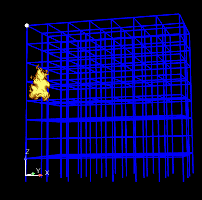Study on the Fire induced Structural Collapse
| Home | My Research |

Paper download
Numerical
models of fire induced progressive collapse analysis for reinforced
concrete frame structures,
Engineering Mechanics, 2012, 29(4): 96-103.
Abstract: Progressive collapse is
the global behavior of the whole structural system. In order to investigate
the fire induced progressive collapse of reinforced concrete (RC) frame
structures, a fiber beam model for RC beam and column and a multilayer
shell model for RC slab are established. For elemental-scale, the sections
at integration points are divided into some fibers or layers. Different
material properties are assigned to various fibers or layers to consider
the contributions of steel reinforcement and concrete. The relationship
between the deformations of the elements and the strains of the fibers
or layers is defined according to the assumption that section remains
plane. For material-scale, temperature-stress coupled loading path is
discretized into sub-increments. The various strains of fibers or layers,
induced by coupled action of temperature and stresses, are calculated
within each sub-increment. The accuracy and efficiency of the models
in simulating the RC beams, columns and slabs in fire are validated
through a series of fire tests. In order to simulate the discontinuous
displacement field during the procedure of structure collapse, the failure
criterion and the deactivation of the structural elements are introduced
to the model. Therefore, the influence of internal force redistribution
induced by element failure on the mechanical response of whole structure
is taken into consideration. At last, a frame structure is analyzed
to study the failure mechanism of its fire induced collapse via the
proposed numerical models.
Keywords: concrete frame structure, fire induced collapse, numerical
model, fiber beam, multi-layer shell, failure
Effect
of spalling on the progressive collapse resistance of reinforced concrete
frame structures,
Journal of Railwal Science and Engineering, 2010, 7(sup.):
154-157.
Abstract: In order to understand
the effect of spalling on the progressive collapse resistance of reinforced
concrete frame structures, an existing simplified spalling model is
employed in the numerical model for collapse analysis of whole structures
in fire. And then the collapse process of an 8-storey frame structure
is simulated. The result indicates that the influence of spalling is
unremarkable on collapse resistance of the whole structure when fire
area is small. Base on the conclusion, some advices for the simulation
of whole structure in fire are proposed.
Keywords: concrete frame structure, spalling, fire-induced collapse
Nonlinear
analysis of multi-story concrete frames under fire with fiber beam model,
Journal of Building Structures, 2009, 30(6): 44-53.
Abstract: In order to analyze and
simulate the response and collapse of multi-story reinforced concrete
frames under fire, a novel numerical model based on the fiber beam model
is proposed in this paper. By dividing the cross section of beam element
into many small concrete and steel fibers, this model can consider the
non-uniform temperature distribution across the section and simulate
the behavior of material nonlinearity and geometry nonlinearity. Then,
the fiber model proposed in this paper is validated by comparing with
experimental results from a one-story, one-bay frame fire test. Finally,
the response and collapse process of a multi-story reinforced concrete
structure is analyzed and the influence of different fire scenarios
is discussed.
Key words: fire response, fiber model, beam element, collapse,
multi-story structures
Numerical
analysis and simulation of space concrete frames under fire
Journal of Natural Disasters, 2007, 6(6):88-92.
Abstract: Based on the fiber element
model and layered shell element model developed and validated by the
authors, this paper establishes the numerical model for space concrete
frames under fire. The connection relationship between the both elementmodels
is also considered and the overall analysis p rocess of space concrete
frames under fire is accomp lished by a system (RCFire) developed for
analyzing the overall behavior of structures under fire. To consider
the non2uniform temperature distribution and material nonlinearity,
the across2sections of the both elements are subdivided into many small
fibers or layers. Finally, a concrete frame structure under fire is
analyzed and the response regularity is investigated. The results can
be used as the reference for the fire safety design of building structures
under fire.
Keywords: fire response; space concrete frame; elementmodel;
numerical simulation
Fiber
beam element model for the collapse simulation of concrete structures
under fire,
Proc. International Symposium on Computational Mechanics
(ISCM2007), Yao ZH & Yuan MW (eds.), Beijing: Tsinghua University
Press & Springer, July 30-August 1, 2007, Beijing, China, 288 &
CDROM.
Abstract: In order to analyze and
simulate the collapse of reinforced concrete (RC) elements under fire,
a novel numerical model based on the fiber beam model is proposed in
this paper. By dividing the cross section of beam element into many
small concrete and steel fibers and assigning different materials to
each fiber, this model can consider the non-uniform temperature distribution
across the section and simulate the behavior of cracking or crushing
for concrete and yielding for steel. The explicit tangential stiffness
matrix is deduced for proposed fiber beam with Total Lagrangian (TL)
description, and the incremental equilibrium equations are also established.
Finally, the proposed fiber model is validated by comparing with various
experimental results.
Key words: fiber model, beam element, fire, collapse, nonlinearity